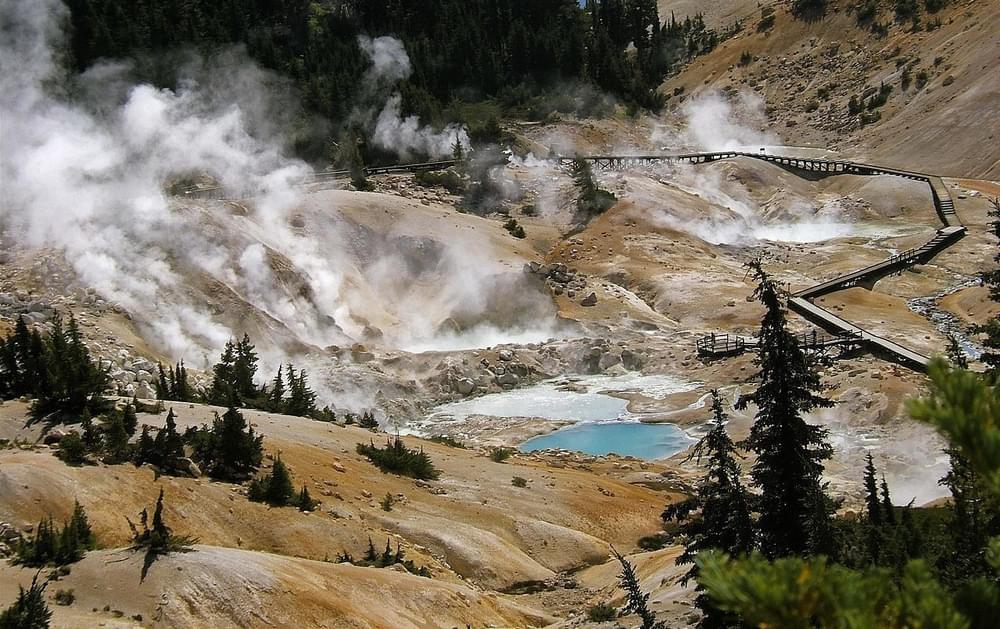




October is the official month for all things spooky, which means for trail enthusiasts, it’s the perfect time to visit these sinisterly named National Recreation Trails.
by Taylor Goodrich, Communication and Media Specialist, American Trails

Designated in 1978, The Devils Den Trail has it all, gravity flow springs, peculiar erosional remnants of sandstone strata, wet weather waterfalls, and lush Ozark plant and animal life. The trail is in Devil’s Den state park, an area which was famously used by outlaws for a mountainous hideout. Learn more...
Designated in 1981, Bumpass Hell is the largest concentration of hydrothermal features in Lassen Volcanic National park. Bumpass Hell was named after an early settler who severely burned a leg after falling into a boiling pool. The hydrothermal features can be reached today from a well-marked 1.5 mile trail that starts from a parking area opposite Lake Helen. Learn more...
This 1.3 mile trail, designated in 1979, leads to a fire lookout that’s been in place for over 100 years, with a 360 degree view of Pike National Forest and plains. Interpretative signs along trail explain the role of forest fires. Trail users climb 948 ft through ponderosa pine/douglas fir forest, to a granite outcrop. Prospectors in the 1800’s named the area Devil’s Head, swearing they could see the face of the devil, horns and all, in the mountain. Learn more...
This 8 mile water trail was designated in 1992, and connects the main road, by water, to Hell’s Bay in the Everglades National Park. You could encounter everything from alligators, to snakes, to sharks on this water trail, but it supposedly got its name for being, “hell to get in and out of.” Learn more...
This fully accessible trail was designated in 1994, but the land features were formed 2000 years ago, when large chunks of the North Crater cinder cone were broken off and rafted to this spot. Subsequent cinder eruptions and plant growth have transformed the area into a volcanic garden. Early morning or evening visits provide the best opportunities for photography and wildlife observation. The trail through this area is as unusual as its name. Learn more...
This trails very unique name comes from the mushrooms that grow along the trail and adjacent creek, which give off an eerie glow resembling that of a Jack-O-Lantern. The spooky name is far from the coolest thing about this trail however. The trail is located in the Booker T. Washington National Monument, which is a preserved Tobacco farm from the 1800’s where Washington was born into slavery. Although there is an official cemetery on the site, the Jack-O-Lantern Branch Trail is also said to have grave sites dotted alongside it. The trail was designated an NRT in 1981. Learn more...
When it comes to the perfect trail for Halloween, it doesn’t get much better than this. The trail is located in a historic Philadelphia cemetery, founded in 1836, and the sprawling location has over 77,000 burials. The cemetery often hosts events such as paranormal activity hunts, and many think there are at least a few ghosts on the premises. This winding 25 mile trail was designated as an NRT in 1990. Learn more...
The Ghost Town Trail is a rail-trail that opened for public use in 1994. The trail is 24 miles long and passes through several abandoned coal towns or "ghost towns" from the early 20th century coal industry. Attracting more than 75,000 annual users, the trail allows people to enjoy the sights, sounds, and beauty of Pennsylvania while hiking, biking, or cross country skiing during every season of the year. Learn more...
Spirit Mound, or Paha Wakan, was known by many tribes before Lewis and Clark expedition came to the area. These tribes told Lewis and Clark that the mound was occupied by little people who shot any human who came near. On August 15, 1804, Lewis and Clark took eleven men and their dog to explore the mound. While they didn't find any "little people", Clark reported that they did see a "most beautiful landscape; numerous herds of buffalo were seen feeding in various directions." Historians recognize the mound as one of few remaining sites where we know with certainty that Lewis and Clark actually stood. The trail was designated as an NRT in 2004. Learn more...
This nature trail, which was designated in 1995, is on land which once belonged to the Cherokee Indians. The area got its name when, in the early trading days of the 1800’s, a cowboy from Texas showed up in the area, and then mysteriously disappeared, with only his skull ever being found. From then on it was known as Skull Hollow. Three different routes are available on the Skull Hollow Nature Trail: Short Loop, Long Loop, and a Hiking Trail. For the adventuresome, the hiking trail is the best. The route takes you along the bluff with excellent vantage points of the lake along the way. The trail loops back off the bluff at Skull Hollow following an old wagon road back to the starting point. An old Verdigris River horse crossing is visible leading down the bluff at this point. Learn more...
Designated in 2013, the overall Hellcat trail system is 5,334 linear feet of elevated boardwalk meandering through dunes, shrub thickets, vernal pools, maritime forest and brackish marsh habitats. Although a hellcat sounds like an animal you wouldn’t want to encounter, the area is renowned for its wildlife viewing opportunities. Learn more...
1,392 views • posted 10/16/2019